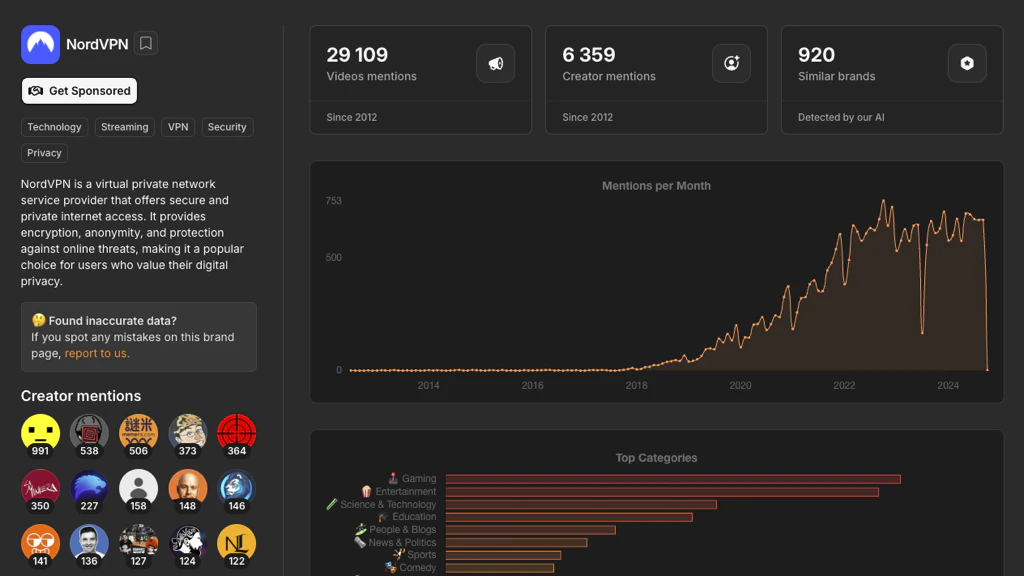
Sponsor guide 101: How do YouTube sponsorships work?
First things to know about YouTube Sponsorships
What Are YouTube Sponsorships and How Do They Work?

Types of YouTube Sponsorships
- Product Reviews: YouTubers and/or influencers making a review of a product or service.
- Sponsored Videos and Branded Content: Creating content specifically for a paid sponsorship. This content can be an entire sponsored YouTube video, or it can also be a product placement within a video.
- Long-term Paid Sponsorships: Receiving a fixed payment for featuring brand sponsorships regularly.
- Affiliate Sponsorships: Earning commissions through affiliate marketing, aka affiliate links. Note that it is also possible for a creator do just sign up to a brand's affiliate program and get commissions without necessarily being sponsored by a brand.
How Much Do YouTube Sponsors Usually Pay?


(For potential sponsors) The Business Side of YouTube Sponsorships
How Brands Choose Content Creators
- Source appropriate creators
- Handle negotiations
- Manage campaign execution
- Track performance metrics
The Role of Agencies
- Work on behalf of brands
- Source multiple creators
- Handle campaign coordination
- Manage budgets and performance tracking
- Represent content creators
- Handle contract negotiations
- Manage sponsorship opportunities
- Typically take 10-20% commission of sponsorship deals
Understanding Campaign Objectives
- Focus on brand awareness
- Less emphasis on immediate sales
- Long-term brand building
- Common for established brands like Nike, Coca-Cola
- Focus on immediate results
- Track specific metrics (sales, sign-ups)
- ROI-driven approach
- Common for digital products and services
(For creators) Preparing Your YouTube Channel for Sponsorships
- Channel Trailer: Create a trailer for your videos that can help highlight what your channel is about.
- YouTube Banner: Use a high-quality banner that represents your brand.
- Content Consistency: Regularly upload high-quality videos, making you more reliable to the brand.
- Video Content: Make sure that your content is engaging to a specific audience and relevant to your niche.
- Keyword Optimization: Use relevant keywords that your audience is likely to search for.
- Social Media Links: Keep linking your social media profiles in your video descriptions, so your audience can find you on different platforms!
Building a Media Kit
- Channel Statistics: Number of subscribers, average views per video, audience demographics.
- Content Portfolio: Examples of your best videos, including at least one video that has performed well.
- Sponsorship Packages: Different sponsorship models and pricing.
- Contact Information: Make sure potential sponsors have a way of contacting you.
How to Reach Out to Brands
- Personalize Your Message: Mention why you think the brand is a good fit for your channel.
- Present Your Value: Talk about your engaged audience and previous successful collaborations.
- Include Your Media Kit: Attach all necessary information upfront to make it more appealing for sponsors to say yes.
Creating Sponsored Content
Leveraging Smaller Channels
- Engaged Audience: Brands often value engagement over sheer subscriber numbers.
- Niche Markets: Smaller, highly-targeted niches can be very attractive to brands.
Long-Term Sponsorships
- Consistent Quality: Maintain high production values and consistent uploads.
- Follow Up: Keep in touch with your sponsors and provide regular performance updates.
FAQs
-
How much do YouTube sponsorships typically cost?
A: Sponsorship rates typically range from $20-70 per 1,000 views, with total costs varying from $3,000 for smaller channels to $10,000+ for larger channels. -
Can small YouTube channels get sponsorships?
Yes, even smaller channels can secure sponsorships, especially if they have a highly engaged niche audience. Micro-influencers often offer great value for brands looking for targeted reach. -
How long does a typical YouTube sponsorship campaign last?
Campaign duration can vary from a single video to long-term partnerships lasting months or even years. The length often depends on the campaign goals and the agreement between the brand and creator. -
Are there any restrictions on what products can be sponsored on YouTube?
Yes, YouTube has guidelines restricting sponsorships for certain products, including tobacco, drugs, and weapons. Additionally, content aimed at children has stricter sponsorship regulations. Creators and brands should always review YouTube's current policies before entering into a sponsorship agreement. -
What percentage do agencies typically take from sponsorship deals?
Reputable agencies typically take 10-20% commission, though some may charge more for additional services. -
How can brands measure the ROI of YouTube sponsorships?
Brands can measure ROI through various metrics, including view counts, engagement rates, click-through rates, and conversion tracking. Many use unique promo codes or dedicated landing pages to track sales directly attributed to the sponsorship. Advanced analytics tools can also provide insights into brand lift and audience sentiment.
The Future of YouTube Sponsorships
AI-Driven Matchmaking
Interactive Sponsored Content
Increased Transparency and Authenticity
Cross-Platform Campaigns
Alexandru Golovatenco
Hi, I'm Alex. I write articles about YouTube sponsorships for brands, content creators, and agencies. I also created sponsorship.so, which is a tool that helps you find the right fit for a YouTube sponsorship.



